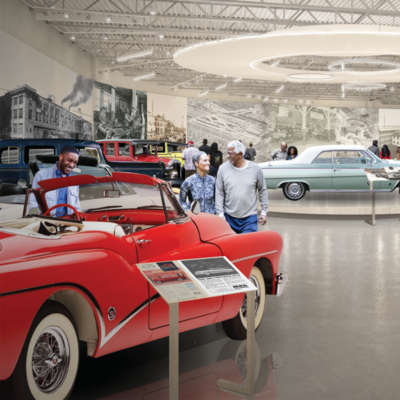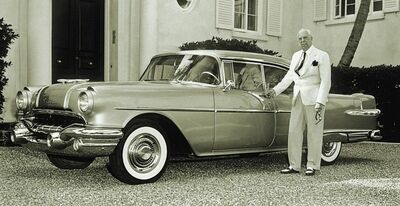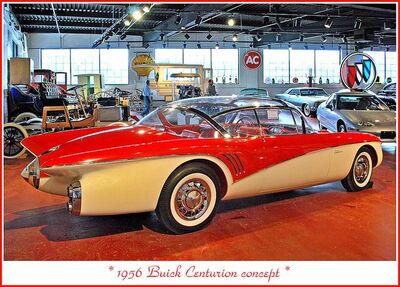The New Sloan Museum of Discovery Flint Michigan
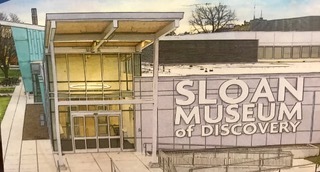 |
The Sloan Museum of Discovery
A Buick “Hellcat” gets its own room at the newly renovated museum
Maureen McDonald, Senior Editor
Steve Purdy, Senior Editor
Michigan Bureau
The Auto Channel
Flint MI August 16, 2022; “Hellcat” is a name most often associated with 6.2-liter V8–powered Dodge muscle cars. with over 700 horsepower. They are among the most powerful cars available to the common gearhead today, and they are veritable cop magnets because of how hard it is to keep your foot out of it.
The new Sloan museum in Flint has another monster Hellcat to pique your interest; but this one is more about shooting straight than raw power. It looks like a tank, though a bit smaller, way lighter, faster and more agile. It was part of GM’s contribution to the legendary “arsenal of democracy” that saved the world.
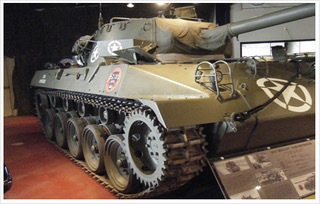 |
The mighty “M-18 Hellcat Tank Destroyer,” made by Buick in Flint for deployment late in World War II, had a top speed of 55 mph (twice that of a tank) with a 350-horsepower, 16-liter, supercharged, 9-cylinder radial engine powering a vehicle with a mass of 37,557 pounds and a price tag of $55,230 in World War II dollars. The M-18 Hellcat occupies its own room in the museum with two photographic murals and a knowledgeable young docent to tell us how the long gun, moderate weight and maneuverability helped the allied troops win the Western Front. The M-18’s job, unlike the tank it resembles, is just meant to kill enemy tanks with precision, not to blow up stuff and people without much finesse, as the conventional tank was designed to do.
The Alfred P. Sloan Museum used to be essentially a car museum annotated with lots of local history. But the new museum, the “Sloan Museum of Discovery,” doubled its size and transformed into a modern, innovative, child-centric attraction with just a fraction of its space dedicated to the automobile and its place in history.
The Durant Gallery, named for the founder of General Motors, William Crapo “Billy” Durant, is where the automobile stories are told. There you’ll find a couple dozen cars (two of which are concept cars from the Motorama era) on display. The dioramas telling the cars stories are still under construction, along with annotations and some interactive elements. Viewers can see motorized buggies like the Road Carts of 1905, cars of the Art Deco era like the beautifully restored 1939 Chevy Master Deluxe, fabulously finned cars of the 1950s, and even an autonomous vehicle pointing to the future.
 |
The completely rethought and redesigned museum cost around $30 million and was broadly funded by foundation grants, government subsidies and private donors. Judging by our mid-summer, mid-week visit, it appears it was a great investment.
The hands-on science part of the museum was swarming with little ones fully engaged in their discoveries and generating a high-pitched din. That area is surrounded by lab and classroom spaces and all the resources needed for a full-service science museum, including a space where future car enthusiasts can ride tricycles through the kid-sized streets and play mechanic at an auto repair shop.
It is clear that the thrill of cars will entice museum viewers for years to come. What starts here with interactive games and a maker space to design car parts, complete with a 3-D printer, inspires the appreciation of cars through all the decades, with the accent on cars built in Flint. From there kids can see the real thing.
On the quieter end of the building (the architect gets high marks for isolating these spaces acoustically) is where we find the Tank Destroyer and the Durant Gallery. Billy Durant created General Motors by buying up one auto company after another and a bunch of parts manufacturers putting them all together in an attempt to dominate the industry. He always thought and acted big, and as a result was always on the financial edge.
The museum bears the name of Alfred P. Sloan, the president and CEO of General Motors, credited with stabilizing the corporation after Durant had assembled the brands, lost the company, and gained control again. He turned GM into one of the largest corporations in the world. The GM Foundation helps power museums like the Sloan.
Cars will remain a keen part of the museum, according to Ann Mansour, marketing manager. We have over 106 cars that we will rotate through our galleries,” Mansour said. The museum holds a variety of fundraising events during the year, including a tour of the warehouses where all these other vehicles are stored.
Among the cars on display are a 1956 Buick Centurion Motorama car with a glass roof, a 1905 Buck Model C and a 1913 Chevrolet Classic Six. The display cars illustrate how the earliest horseless carriages with tiny engines beneath the seat evolved over the decades into what we know today and what we expect in the future.
The Sloan Museum of Discovery anchors a complex of facilities – art museum, planetarium and other assets – that encompass a cultural center more impressive than you might expect in a city that has struggled as much as Flint.
© Shunpiker Productions and Maureen McDonald



